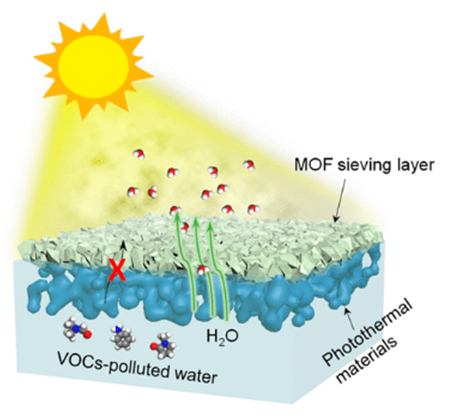Metal−Organic Framework Composite Photothermal Membrane for Removal of High-Concentration Volatile Organic Compounds from Water via Molecular Sieving
Yubing Peng1, Xian Wei1, Yunjie Wang2, Wenwei Li2, Shenxiang Zhang1,*(张慎祥), and Jian Jin1,*(靳健)
1College of Chemistry, Chemical Engineering and Materials Science, Collaborative Innovation Center of Suzhou Nano Science and Technology, Suzhou Key Laboratory of Macromolecular Design and Precision Synthesis, Soochow University, Suzhou 215123, China
2CAS Key Laboratory of Urban Pollutant Conversion, Department of Applied Chemistry, University of Science & Technology of China, Hefei 230026, China; USTC-CityU Joint Advanced Research Center, Suzhou 215123, China
ACS Nano 2022, 16, 5, 8329--8337
Water-soluble volatile organic compounds (VOCs) are among the most difficult-to-treat species during wastewater treatment. The current purification and removal of high-concentration VOCs still rely on the energy-consuming distillation and high-pressure driven reverse osmosis technology. There is an urgent need for an advanced technology that can effectively remove high-concentration VOCs from water. Here, we report a metal–organic framework (MOF)/polyaniline (PANI) nanofiber array composite photothermal membrane for removal of high-concentration VOCs from water via molecular sieving during a solar-driven evaporation process. The modified zeolitic imidazole framework-8 (ZIF-8) layer grown on a PANI nanofiber array acts as a molecular sieving layer to evaporate water but intercept VOCs. The composite membrane exhibits high VOCs rejection and a high-water evaporation rate for water containing different concentrations of VOCs. When treating water containing VOCs with a concentration of up to 400 mg L–1, the VOCs rejection rate is up to 99% and the water evaporation rate is 1.0 kg m–2 h–1 under 1 sun irradiation (1 kW m–2). Our work effectively combines the molecular sieve effect with a solar-driven evaporation process, which provides an effective strategy for the treatment of water containing VOCs.

链接://pubs.acs.org/doi/10.1021/acsnano.2c02520